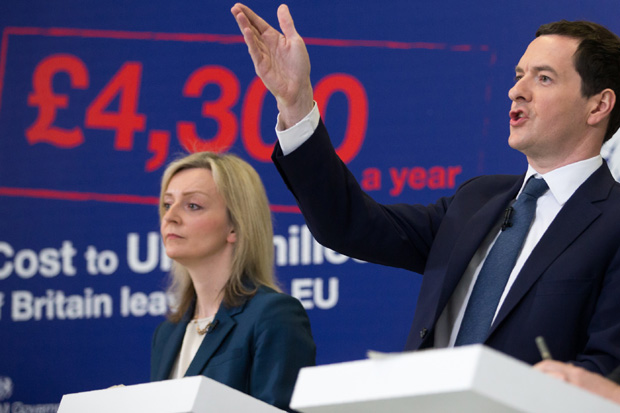When the FTSE100 fell close to 5,500 in February, we all said ‘Mr Bear is back’. On Tuesday the index hit a high for this year of 6,400, and we all wondered whether Mr Bear had done what I said he wouldn’t, and shuffled back to hibernation. But the truth is that shares have lately moved in parallel with the oil price, which has perked up partly for technical reasons including temporary curtailment of supply from Kuwait; and a major element of the FTSE recovery is in commodity stocks that had been wildly oversold. So we shouldn’t read any great swing of confidence into a market still 600 points down on a year ago. If, for example, you bought Rio Tinto on the strength of our Spectator Money tip in early March, you’re quids in by 15 per cent so far — but bearing in mind uncertainties ahead, from the Brexit vote to the rise of Trump, you might want to recall an old City adage: ‘Sell in May and go away.’
No more forecasts please
The most striking thing about the Treasury’s forecast of the impact of Brexit is the relative modesty of its claim that by 2030, assuming a UK-EU trade deal akin to the one negotiated by Canada, ‘our GDP would be 6.2 per cent lower’ while ‘families would be £4,300 worse off’. Since those quotes come from the foreword signed by George Osborne, many voters will distrust the whole document — in which case they might prefer the even more modest ‘worst case’ of a 2.2 per cent GDP hit by 2030 predicted by non-partisan think-tank Open Europe alongside what it calls ‘a far more realistic’ range of possible outcomes ‘between a 0.8 per cent permanent loss to GDP… and a 0.6 per cent permanent gain’. If we take a middle way through all these forecasts, the most likely outcome is a run of small annual falls in GDP, after a big jolt at the start. A significant minority foresees the opposite: small annual GDP gains as a result of deregulation and souped-up trade. But ‘small’ is key either way; and before 2030 we must also be due at least one recession and a couple of downturns. The worst such episode in recent times was a 5.2 per cent single-year GDP fall in 2009, reminding us that a ‘black swan’ — bank crash, energy price spike, nuclear conflict — could have far greater impact than Brexit. By 2030 it will be impossible to unravel the effects of leaving or remaining from the effects of everything else that has happened in the lottery of life. Both sides should admit that forecasting is bunk (to adapt Henry Ford) and neither should pretend Brexit will be catastrophic or miraculous. If they must talk about economics, both should focus on real-life examples of how EU membership has hindered or helped British business and prosperity.
On the steel front
Ministers from 34 countries met in Brussels this week in the vain hope of a quick fix for the steel crisis that everyone blames on dumping by China — which responded, through a state news agency, by calling its critics ‘lame and lazy’. Our own Sajid Javid, desperate to avert the fallout from a closure of Tata’s Port Talbot steelworks before the referendum, claimed to have observed ‘a very positive step forward’ in Chinese attitudes, but perhaps someone had locked him in his hotel room.
Meanwhile, Greybull Capital completed its purchase of Tata’s Scunthorpe plant and Liberty House took over two Tata mills in Lanarkshire — confirming my view that specialised elements of UK steel have life ahead but Port Talbot’s blast furnaces, despite talk of a management buyout, probably don’t. What’s interesting is the way ministers are positioning themselves to co-invest in a Port Talbot rescue — which would mean part-renationalisation. Such Canute-like use of taxpayers’ money to avert bad newsreel footage (very different from part-nationalising RBS and Lloyds to save the banking system) ought to be unthinkable for a Tory government. Watch out for some fancy rhetoric about the unlevel global playing field that makes steel a special case.
One fine price
My thanks to Julie Meyer, fragrant doyenne of London’s tech investors, for pointing out the significance of the £117 million takeover by Accor, the French hotelier, of the home-letting website Onefinestay. Accor owns a huge range of hotels, from Ibis budget stopovers to the stylish Sofitel chain, and recently spent £1.9 billion on the luxury group that includes the Savoy. Onefinestay is the posh end of the ‘sharing economy’ — an upmarket Airbnb, offering 2,600 elegant homes around the world. Founded in 2010, it’s still far from breakeven: previous investors must be relieved to be bought out by Accor for more than seven times 2014 turnover. But Onefinestay offers a strategic stake in the way monied global travellers are adapting to the era of digital choice. In old money, £117 million would have bought no more than a tired four-star hotel on the Bayswater Road.
City comeback?
I’m glad to see former Bank of England deputy governor Sir Paul Tucker tipped to succeed Sir John Peace as chairman of Standard Chartered. Well respected in the City and long tipped to succeed previous governor Mervyn King, Tucker fell from favour after a Libor-related tangle with Bob Diamond and an unhappy Treasury select committee appearance. He left the Bank in 2013, shortly after Mark Carney arrived, to take up a fellowship at Harvard. I last saw him at Buckingham Palace, queuing for his knighthood — rather dejectedly, I thought — behind the gleaming PR man Alan Parker; the contrast between them offering a cameo of the inadvertencies of fate in high-flying careers. The chair of Standard Chartered, with its baggage of losses and scandal, is no cushy number — but Tucker was a decent public servant, and he deserves a break back into the mainstream.







Comments